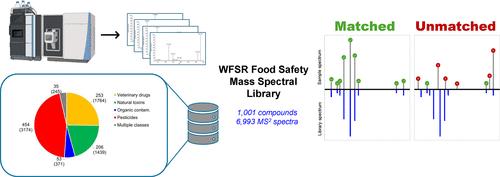Creation of an Open-Access High-Resolution Tandem Mass Spectral Library of 1000 Food Toxicants
IF 6.7
1区 化学
Q1 CHEMISTRY, ANALYTICAL
引用次数: 0
Abstract
Spectral library searching is a key method for compound annotation in mass spectrometry; however, existing libraries often suffer from high data heterogeneity, varying spectral quality, or limited accessibility. These issues are particularly significant in food safety, where the lack of comprehensive reference data hampers the identification of hazardous compounds. To address these limitations, we developed the WFSR Food Safety Mass Spectral Library, a freely accessible tandem mass spectral library focused on food contaminants, residues, and hazardous compounds. This library contains 6993 manually curated spectra from 1001 compounds acquired in positive ionization mode using ultrahigh-performance liquid chromatography coupled to an Orbitrap IQ-X Tribrid mass spectrometer. Spectra were recorded at seven collision energies under standardized conditions. Comprehensive metadata are provided, including common names, CAS, SMILES, InChIKeys, retention times, and compound classes. The library is publicly available via a dedicated website (https://www.wur.nl/en/show/food-safety-mass-spectral-library.htm) and through the GNPS repository, adhering to FAIR data principles to facilitate community reuse. Comparisons with major repositories (GNPS, MassBank, MoNA, and MSnLib) showed that 216 compounds (22.2%) are unique to our library. Further analysis using molecular networking and MS2Query revealed that about 38% of the compounds lack reliable matches in public libraries. The WFSR spectral library is designed to improve the annotation of food toxicants and facilitate the identification of structural analogues using computational tools. This library is part of an ongoing initiative with future updates planned to include negative ionization mode spectra and an expanded compound repertoire, aiming to advance food safety monitoring.

创建1000种食品毒物的开放获取高分辨率串联质谱库
谱库检索是质谱中复合标注的关键方法;然而,现有的库经常遭受高数据异构性、谱质量变化或有限的可访问性的困扰。这些问题在食品安全方面尤为重要,因为缺乏全面的参考数据妨碍了对有害化合物的识别。为了解决这些限制,我们开发了WFSR食品安全质谱库,这是一个免费访问的串联质谱库,专注于食品污染物,残留物和有害化合物。该文库包含6993个人工整理的光谱,来自1001种化合物,采用超高效液相色谱法与Orbitrap IQ-X Tribrid质谱联用,以正离子模式获得。在标准化条件下记录了七种碰撞能量下的光谱。提供了全面的元数据,包括通用名称、CAS、SMILES、InChIKeys、保留时间和复合类。该库通过一个专门的网站(https://www.wur.nl/en/show/food-safety-mass-spectral-library.htm)和GNPS存储库向公众开放,遵循FAIR数据原则,以促进社区重用。与主要库(GNPS、MassBank、MoNA和MSnLib)的比较表明,216个化合物(22.2%)是本文库独有的。利用分子网络和MS2Query进一步分析发现,大约38%的化合物在公共文库中缺乏可靠的匹配。WFSR光谱库旨在改进食品毒物的标注,并便于使用计算工具识别结构类似物。该库是一个正在进行的计划的一部分,未来的更新计划包括负电离模式光谱和扩展的化合物曲目,旨在推进食品安全监测。
本文章由计算机程序翻译,如有差异,请以英文原文为准。
求助全文
约1分钟内获得全文
求助全文
来源期刊

Analytical Chemistry
化学-分析化学
CiteScore
12.10
自引率
12.20%
发文量
1949
审稿时长
1.4 months
期刊介绍:
Analytical Chemistry, a peer-reviewed research journal, focuses on disseminating new and original knowledge across all branches of analytical chemistry. Fundamental articles may explore general principles of chemical measurement science and need not directly address existing or potential analytical methodology. They can be entirely theoretical or report experimental results. Contributions may cover various phases of analytical operations, including sampling, bioanalysis, electrochemistry, mass spectrometry, microscale and nanoscale systems, environmental analysis, separations, spectroscopy, chemical reactions and selectivity, instrumentation, imaging, surface analysis, and data processing. Papers discussing known analytical methods should present a significant, original application of the method, a notable improvement, or results on an important analyte.
 求助内容:
求助内容: 应助结果提醒方式:
应助结果提醒方式:


